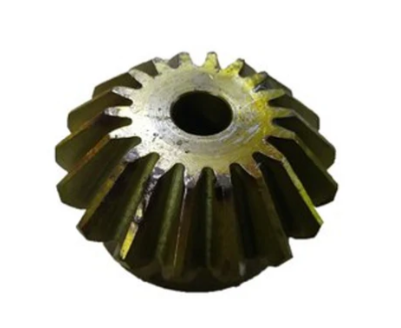Notifications

7 minutes, 7 seconds
-177 Views 0 Comments 0 Likes 0 Reviews

Little and sophisticated machines in mechanical engineering depend on effective motion transmission. Among all the components used for this, the bevel gear is a masterwork of precision craftsmanship. Its rugged design and flexibility make it an integral component of equipment that requires reliable and effective transmission of power. Converting and channelling mechanical force with remarkable precision, this gear design has transformed the art of machine design, maximizing performance while conserving space.
The unique geometry of bevel gears and their mechanical advantages
These gears are unique because they are conical in design and thus transfer motion from intersecting shafts to one another effectively. Unlike parallel-axis gears, these gears specifically transmit power in different directions, typically 90 degrees. Their novel geometry transmits energy from one mechanical element to another in as fluid a fashion as possible, thus minimizing friction and wear.
Such gears are far more durable than conventional gears because of their design to transmit motion precisely and consistently. Its versatility of operation at any angle makes these gears the indispensable component of a wide variety of mechanical setups.
The versatility of these gears is the way they can work in different directions. Automobiles, turbines, and industrial robots rely heavily on it for devices that require small form and angular acceleration. These gears ensure correct torque and motion alignment, which boosts production and machine lifetime by themselves. Their ability to control heavy-load and high-speed applications shows even more their mechanical excellence.
Materials and manufacturing techniques define the bevel gear's performance
The manufacturing methods and materials applied to produce bevel gears affect their longevity and performance. The most commonly used materials are high-quality steel, alloys, and other tough metals, which will resist aging over the long term. Heat imparts additional machinability and durability, and this makes these gears suitable for high demands.
Better manufacturing methods such as precise machining and 3D simulation improved the quality of these gears. These practices enable you to align teeth perfectly, so you can engage smoothly and use less energy. New gear cutting and finishing technologies also cut noise and vibration, which is critical for high-performance uses. This means that these gears now provide a degree of efficiency unseen before, even in the most challenging conditions.
How these Gears Adapt to Complex Machine Requirements
Bevel gears are fundamental to mechanical design and operation. They are so flexible in their capacity for non-parallel axes that they are the essential tool for creating efficient and creative machine architectures. These gears simplify elaborate mechanical configurations by making motion transfer straightforward while providing outstanding stability and accuracy.
What sets them apart is their ability to provide consistent performance at extreme speeds or pressures without sacrificing safety or performance. This makes them ideal for applications that demand strength and precision. They make machines durable and efficient by providing seamless motion over multiple axes, whether in an automobile or an airplane or in high-end manufacturing. They also help prevent mechanical failure, giving engineers the latitude to create complex systems that put efficiency and reliability first.
Such gears, whether in gearboxes, industrial conveyors, or any mechanical construction, significantly improve overall performance. Applications that require flexibility and precision depend on their security, stability, and consistency.
How Technological Developments Are Changing Bevel Gears' Future
Bevel gear manufacture and form have changed with technological developments. Advances like finite element analysis and CAD software allow engineers to make fine adjustments on gear configurations. These discoveries gave rise to lightweight and powerful gear systems, capable of delivering the performance and stability demanded by today’s machines. This advancement makes bevel gear systems more easily adaptable to changing industrial requirements.
This breakthrough in material science also led to the development of lighter but stronger bevel gears. Engineers are using composites with high-performance alloys to create highly efficient, yet lightweight, machine gears. This upgrade not only improves performance; it also promotes sustainability by lowering energy consumption.
Further, bevel gears combined with automated mechanisms and smart electronics are also creating entirely new avenues for machine design. By adding sensors and live monitoring, bevel gears are becoming more responsive to a changing environment and will continue to deliver consistent performance under varying conditions. These advances positioned bevel gears at the core of contemporary engineering, therefore enabling the possibility for more creative, more powerful machines.
Conclusion
For mechanical motion transfer, then, bevel gears are an essential development. Their particular form, strength, and versatility make them ideal for small and sophisticated tools used in many different fields. These parts greatly increase the dependability and lifetime of contemporary machines by effectively spreading energy and guaranteeing exact alignment. Their role in enhancing performance and maintaining smooth operations demonstrates their significance in propelling the technology that shapes our planet.
If you’re looking for the right components to complement your mechanical designs, experts such as KitsGuru have plenty of creative options. Known for educational kits, DIY projects, and technical gadgetry, they let novices and experts experience the promise of advanced engineering. With their dedication to quality and training, such trustworthy professionals ensure each project delivers the highest levels of success.

